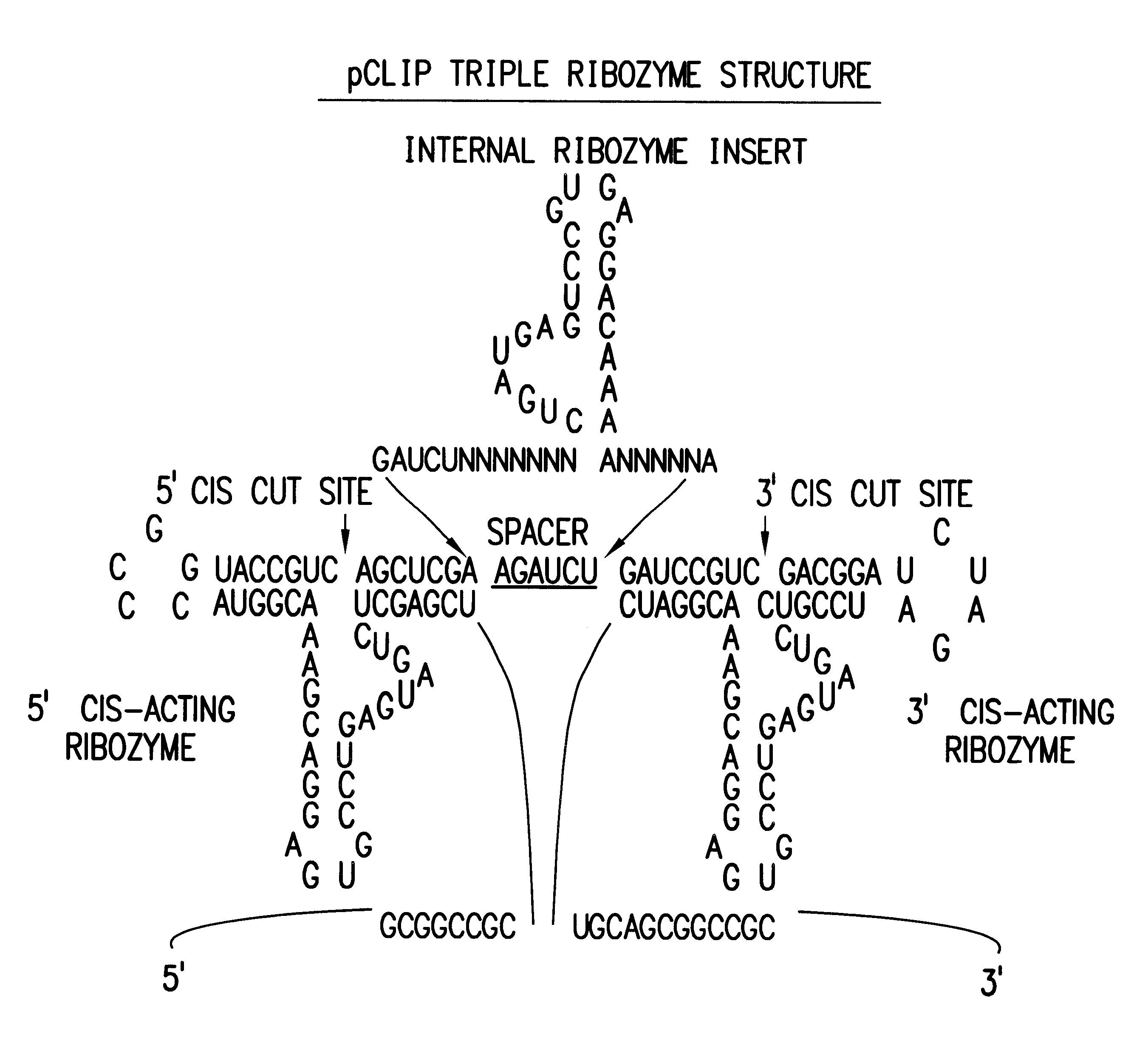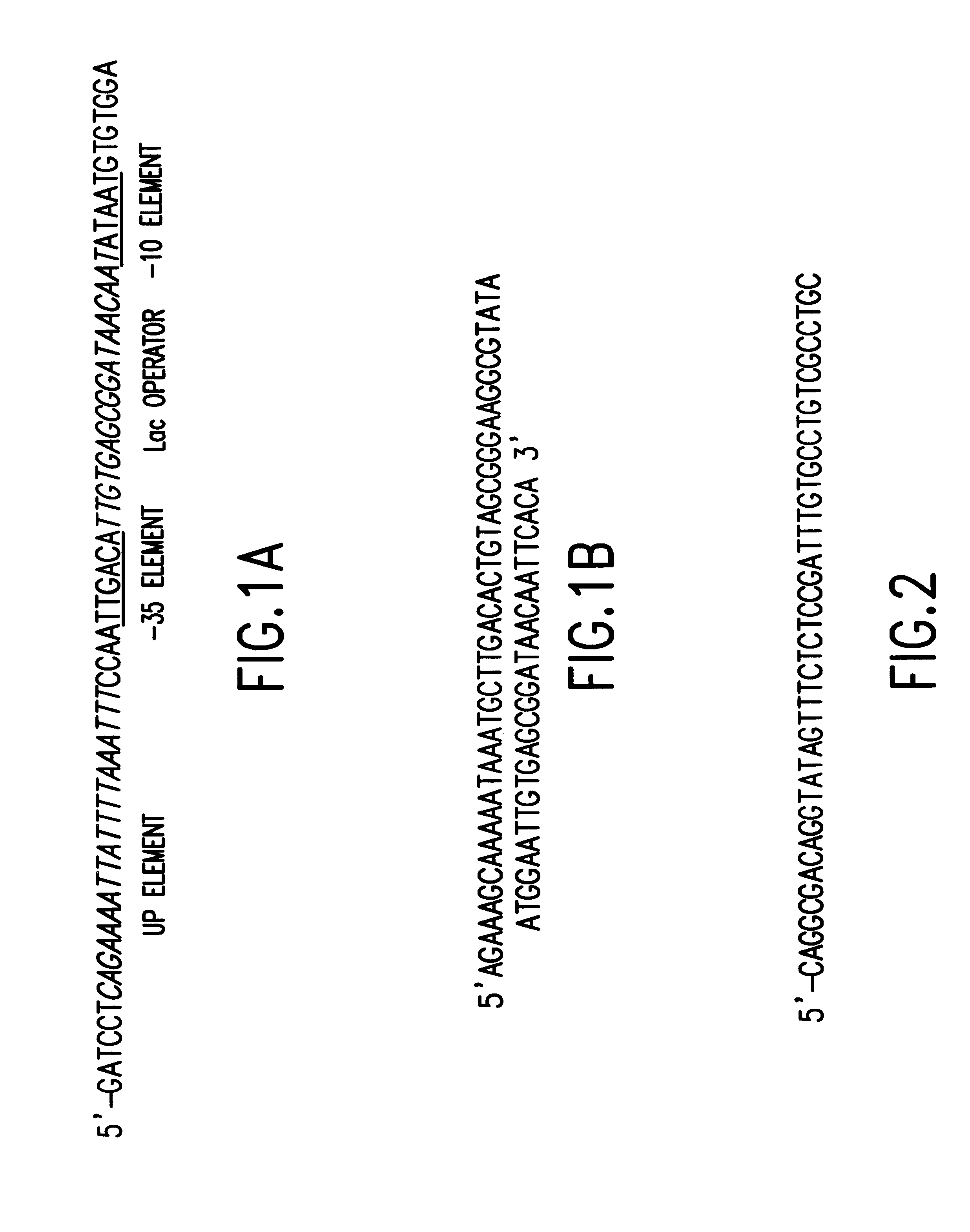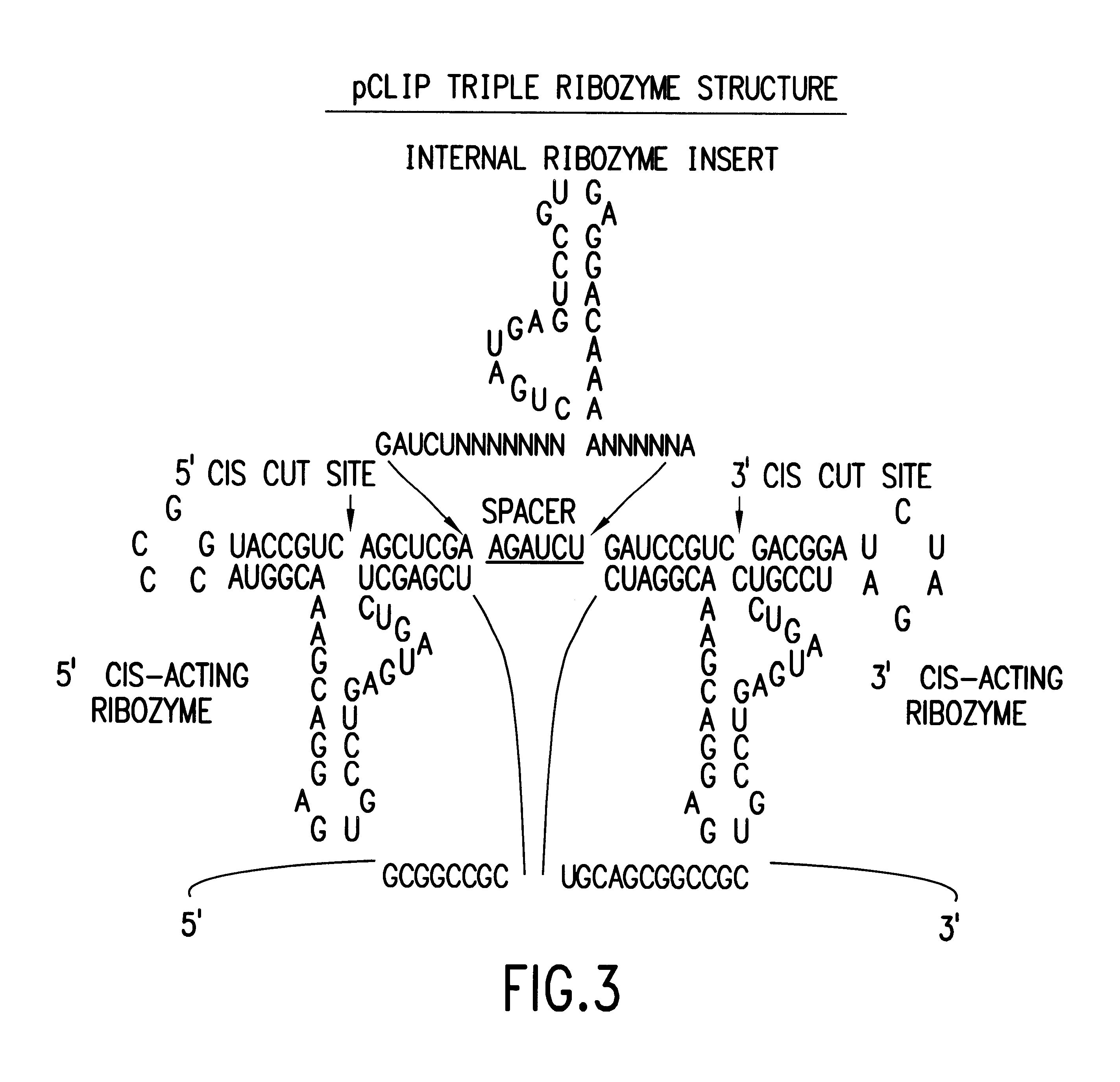The invention also provides for toxic agents or ribozymes containing modifications which enhance stability and protect against degradation. Examples of such modifications include those which protect against degradation by endonucleases such as modifications to the structure of the nucleotides and stabilizing hairpin loops in or near the ribozyme cassette. In one embodiment, the present invention a toxic agent or ribozyme is stabilized by a 3' hairpin loop.
The invention additionally provides nucleic acids and expression cassettes which
encode the toxic agent and / or ribozymes of the invention. These nucleic acids can be used to express the toxic agent and / or ribozyme of the invention at the selected site. In one embodiment, the
nucleic acid comprise a tissue-specific promoter operably linked to a toxic agent. In another embodiment, the nucleic acids and expression cassettes of the invention comprise a tissue-specific promoter operably linked to a sequence encoding a catalytic ribozyme comprising one or more target
RNA-specific trans-acting ribozymes and one or more toxic agents. In another embodiment, the nucleic acids comprise a pathogen-specific promoter from a sequence encoding a toxic agent. In another embodiment, the nucleic acids and expression cassettes of the invention comprise a pathogen-specific promoter operably linked to a sequence encoding a 5' autocatalytically cleaving ribozyme sequence, a catalytic ribozyme comprising one or more target
RNA-specific trans-acting ribozymes and / or pathogen-specific toxic agents, and a 3' autocatalytically cleaving ribozyme sequence. In accordance with the present invention, the expression cassettes may be engineered to express two or more multi-ribozymes containing trans-acting ribozymes which act on the same or different targets. The expression cassettes may also be engineered to express two or more multi-ribozymes containing 5' and 3' autocatalytically cleaving ribozymes with either slow or enhanced cleavage activity.
In other embodiments, the invention provides nucleic acids and expression cassettes which
encode multi-ribozymes with altered cleavage sites, so that the 5' and / or 3' autocatalytically cleaving ribozymes have enhanced activity, resulting in the more effective and efficient release of the targeted internal ribozymes or toxic agents. In an additional preferred embodiment the invention provides nucleic acids which
encode multi-ribozymes with one or more trans-acting ribozymes, resulting in the more effective and efficient cleavage of target
RNA. In an additional embodiment, the invention provides for
nucleic acid that encode one or more ribozyme cassette each containing a) a 5' autocatalytically cleaving ribozyme sequence, b) catalytic ribozymes comprising one or more target RNA-specific trans-acting ribozymes and / or one or more toxic agents and c) a 3' autocatalytically cleaving ribozyme. In another embodiment, the expression cassettes encode autocatalytically cleaving ribozymes combinations of slow and enhanced cleavage activities resulting in a distribution of liberated trans-acting ribozymes or toxic agents between the
nucleus and
cytoplasm of a
eukaryotic cell. In yet another embodiment, the
expression cassette encodes enhanced autocatalytically cleaving ribozymes resulting in an increase accumulation of the liberated trans-acting ribozymes or toxic agent in the
nucleus.
A toxic agent may also be used in combination with one or more ribozymes. Further, a combination of ribozymes and toxic agents may be used as an
antimicrobial therapeutic. These approaches offer advances for
antimicrobial therapeutics: (1) the preparation bypasses any de novo built-in
drug resistance, which sophisticated microbes will be expected to have or develop (2) cells are generally not capable of counteracting ribozymes delivered into them, (3) microbes have several broad RNA targets and non-RNA targets that can be attacked in simultaneously with probable
synergy, (4) the custom design of the present
delivery vehicle can be readily tailored to different families of organisms or different species of organisms, (5) the modified
delivery vehicle is a construct easy to assemble and manufacture, (6) the preparation can be applied topically or it can be delivered via injection,
inhalation, or
ingestion, (7) the preparation can be lyophilized and thus confer stability to the antimicrobial therapeutic, (8) the inhalant, ingested or topical form of the antimicrobial therapeutic reduces the
immunogenicity of the therapeutic preparations as opposed to its parenteral use, and (9) animal test systems exist that enable the evaluation of the ribozymes and / or toxic agents of the invention, in a measured, incremental fashion to quickly determine the
efficacy of the antimicrobial therapeutic agent. Therefore, the unique delivery approach and an aggressive mechanism for depriving the microbial cells of essential or important
gene products can achieve the timely defeat of microbes within the host.
The present invention further encompasses the use of the toxic agents and / or ribozymes of the present invention for research and screening purposes. In one embodiment of the present invention, the ribozymes and / or toxic agents may be used to screen for viral, microbial, prokaryotic, or
eukaryotic gene products or molecules to be targeted in order to effectively inhibit the selected
virus or
microbial agent or selected cell.
In yet another embodiment, the present invention relates to a novel vector encoding the toxic agent(s) and / or ribozyme(s). The novel vectors of the present invention encode one or more toxic agents and / or ribozyme(s) which are rapidly and effectively expressed in a cell or pathogen. The novel vectors of the present invention may encode unique 5' and 3' autocatalytically cleaving activity, so that the one or more internally encoded ribozymes and / or toxic agents are rapidly and effectively released. The novel vectors of the present invention may be used to engineer a wide variety of toxic agents and / or ribozymes including, but not limited to, tissue-specific, pathogen-specific, promoter-specific, antimicrobial specific, antiviral specific, anticancer specific, antitumor specific, or target-specific.
 Login to View More
Login to View More 


